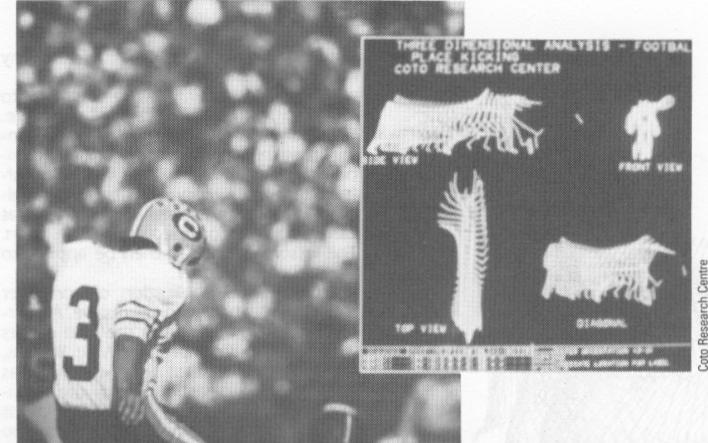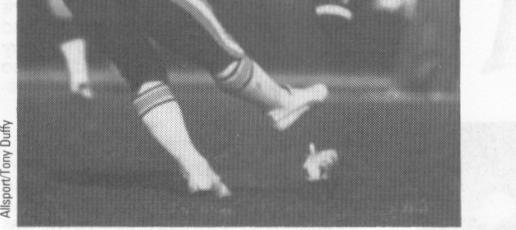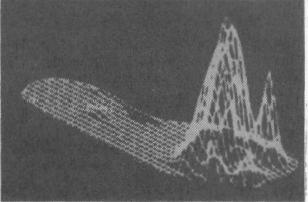| Previous | Index |
![]()
Below A graphic Illustration of the pressure variation over the sole of the foot. The main area of pressure is on the ball of the foot
one advantage of running with long strides is the reduction in the number of strides. But biomechanical analysis indicated that each running stride is associated with a braking force which stops the forward motion of the athlete. The larger the stride the greater the braking force. Ariel calculated that the optimum stride length occurred when the braking force was at a minimum. He reckons that the calculation of the precise relationship between stride and braking force could increase the individual's running efficiency by as much as 20 per cent. Leaning forward at the hip also contributes marginally to running efficiency, as does landing on the ball of the foot rather than the heel.
But although guidelines and techniques
can be posited, there is no perfect formula for any given activity. Every individual has his own specific centre of gravity and type of body-build, and perfection lies in the in
dividual's ability to make use of the findings of his own personal analysis.
Another Ariel creation - designed to accommodate each individual's need - is the Ariel-Wilson 4000 Exercise Computer. Initially used as a training device by the Dallas Cowboys American Football team, the unit monitors hydraulic lifts. These function like barbells, but their pressure can be specifically tuned to match needs and so maximize each player's work-out efficiency. Each Dallas Cowboy had his own physical profile cassette - a floppy disc capable of storing up to a million pieces of information about the player's physiology; his strengths and weaknesses; his body peculiarities and fitness goals. The computer uses this profile to adjust the pressure, speed and duration of the 4000's drills.
It can even build up a weakened knee after a surgical operation, by presenting it with the most appropriate amounts of pressure each day, while keeping the other leg in peak condition with the full training weight. The biomechanical equivalent of the physiotherapist has arrivedl
And the precision of biomechanics can be used in the prevention of injury as well as in rehabilitation. By showing the individual how to move properly without putting any unnecessary strain on any part of
the body, Aeriel's analysis can improve posture and prevent pain - increasing the athlete's chances of real success at the same time.
Ariel has applied the biomechanical analysis techniques to films of athletes in action. In one study, he compared Jesse Owens' performance in the 1936 Munich Olympics to that of the 1977 world record holder for the 100 metres - Eddie Hart. Owens ran on a cinder track, without starting blocks, in 10.2 seconds. Hart's record - on a polyurethane track, with blocks - was 9.9 seconds. Ariel calculated how many degrees per second their ankle, hip and knee joints displaced. He knew the length of the bones and the speed of the film frames -so he also knew how much distance was covered per second. He let each man cover 100 metres, and computed the time it took him. Jesse Owens won.
Real-time digitizing
Digitizing from film is an expensive and time-consuming process - the film needs to be developed before the computer analysis can properly begin. So Ariel is working on what he calls 'real-time digitizing' where the feedback to the subject would be immediate. At present, video does not have the resolution to be a viable alternative to film but infra-red sensing equipment may be the answer. Ariel has developed a device called Selspot which uses infra-red lightemitting diodes to transmit the position of the objects to which they are fixed. For example, he can fix hundreds of diodes to the shaft of a golf club with each diode attached to a source of electricity. The diodes put out thousands of signals a second which are picked up by two cameras and fed to a processing unit. Any golfer swinging his club can get an immediate analysis of his action.
But this does not mean we are all destined to be champions. Knowing our mistakes is one thing - being able to correct them is another.
At the Coto Research Centre, another instant analysis machine can determine a multiplicity of movements when a subject moves on a force plate known as the Kistler Force Platform. The person's movement on the plate is transmitted by means of sensitive detectors to the Selspot II system which, with the help of a computer, provides immediate feedback - as either a twoor three-dimensional image of the action.
Biomechanics can be applied to the world with which the body reacts as well as the body itself - in the design of running shoes, tennis shoes, weight machines, and in the study of industrial environments, ergonomics and safety precautions. Dr Ariel has even received a request from the US government to research into the force which comes into play when a ketchup bottle is shaken. The consequences could be far reachingI
INDEX: Physiology. Sports technology. SCIENCE NOW VOL. I, PART 5 1982
where the highest peak occurs. Here the greatest shock absorption properties are needed to aid running.
Above A threedimensional analysis of football place kicking. The stick figures show four different views of the same action. From such data it is possible to work out all the forces and angles at work, and to Improve the player's technique.



![]()
| Previous | Index |